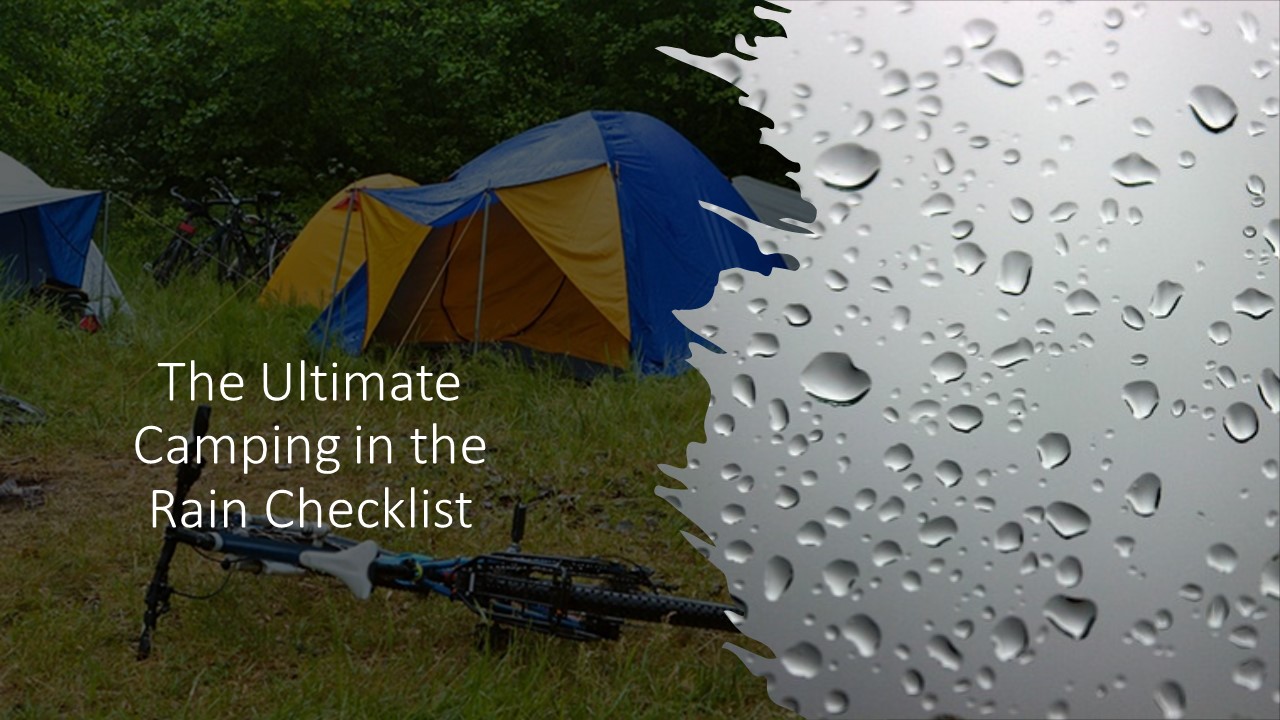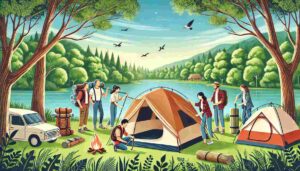Camping in the rain can be a unique and exhilarating experience, offering a different perspective on outdoor adventures. However, it also presents its own set of challenges that can quickly dampen the fun if you’re not adequately prepared. That’s why having a comprehensive camping in-the-rain checklist is essential to ensure a safe and enjoyable outing amidst inclement weather.
In this article, I will delve into the expert tips and advice you need to navigate the rain-soaked wilderness with confidence. From choosing the right gear to campsite preparation, essential rain gear, food and cooking considerations, safety measures, entertainment, and comfort, I’ll cover every aspect to make your camping experience in the rain unforgettable.
So, let’s dive into the checklist and discover how to embrace the rain while keeping dry and comfortable throughout your outdoor escapade.
Choosing the Right Gear
When it comes to camping in the rain, selecting the appropriate gear is paramount. Here are some essential items to consider:
Selecting a Waterproof Tent
- Opt for a tent with a reliable rainfly: A rainfly is a separate waterproof cover that goes over the tent to provide an extra layer of protection against rain. Ensure the rainfly fully covers the tent and extends to the ground for maximum waterproofing.
- Check the tent’s waterproof rating: Look for tents with a high waterproof rating, indicated by the “hydrostatic head” measurement. Aim for a rating of at least 1500mm to withstand heavy rain.
- Seam sealing and bathtub floors: Choose a tent with sealed seams to prevent water from seeping through. Additionally, a bathtub-style floor design, where the tent floor curves up around the edges, helps keep water out.
Sleeping Essentials
- Waterproof Sleeping Bag or Sleeping Bag Liner: Invest in a sleeping bag that offers excellent water resistance or consider using a waterproof sleeping bag liner. This will keep you dry and warm even if moisture finds its way into the tent.
- Sleeping Pad or Air Mattress with Moisture-Resistant Properties: Use a sleeping pad or air mattress designed to repel moisture. This prevents water from seeping up from the ground and helps maintain insulation.
Clothing and Footwear
- Layering Techniques for Rain Protection: Dressing in layers is key to staying comfortable in wet conditions. Start with a moisture-wicking base layer, add insulating layers, and top it off with a waterproof and breathable outer layer.
- Waterproof and Breathable Clothing Options: Look for rain jackets and pants made from waterproof materials like Gore-Tex or similar fabrics. These offer both water protection and breathability, allowing perspiration to escape.
- Durable and Waterproof Footwear: Opt for waterproof hiking boots or shoes with a sturdy outsole for traction. Ensure they are properly broken in before your camping trip to prevent discomfort and blisters.
Investing in high-quality gear ensures durability and comfort throughout your trip.
Campsite Preparation
Proper campsite preparation is essential for a successful and comfortable camping experience in the rain. Here are some important considerations:
Location Selection
- Choose a High and Well-Drained Campsite: Look for elevated areas away from low-lying spots or valleys where water tends to accumulate. Avoid setting up camp near rivers, streams, or potential flood zones.
- Avoid Areas Prone to Flooding: Research the campsite’s history and check for any flood warnings or past incidents. Avoid areas with signs of poor drainage or standing water.
Setting up Camp
- Clear the Area of Debris and Potential Water Flow Paths: Before pitching your tent, remove any branches, rocks, or debris that may obstruct water flow. Clearing the area helps prevent water pooling around your campsite.
- Utilize Tarps or Ground Sheets for Added Protection: Place a waterproof tarp or groundsheet underneath your tent to create an additional barrier between the wet ground and the tent floor. This prevents ground moisture from seeping through.
Rainwater Management
- Creating Trenches or Channels: Dig shallow trenches or channels around the perimeter of your campsite to redirect rainwater away. This helps prevent water accumulation and potential flooding.
- Consideration of Natural Drainage Patterns: Observe the natural terrain and choose a campsite that aligns with the existing water drainage patterns. Avoid camping in low-lying areas where water may naturally flow.
Taking the time to carefully select and prepare your campsite ensures that you’ll have a drier and more comfortable experience even in rainy conditions.
Essential Rain Gear
To stay dry and comfortable during camping in the rain, it’s crucial to have the right rain gear. Here are some essential items to include in your camping in the rain checklist:
Rainwear for Campers
- Waterproof Jackets with Proper Ventilation: Look for rain jackets made from waterproof and breathable materials like Gore-Tex or similar fabrics. These jackets keep rain out while allowing sweat and moisture to escape.
- Rain Pants or Waterproof Trousers: Pair your waterproof jacket with rain pants or waterproof trousers to provide complete lower body protection from rain and wet vegetation.
- Hats or Hoods for Head Protection: Wear a hat with a brim or use the hood attached to your jacket to keep rain off your face and maintain visibility.
Hand Protection
- Waterproof Gloves or Mittens: Invest in waterproof gloves or mittens to protect your hands from getting wet and cold. Look for options that offer dexterity for various activities.
- Quick-Drying Hand Towels: Keep a couple of quick-drying hand towels handy to dry your hands after being exposed to rain or wet surfaces.
Additional Rain Gear
- Ponchos or Rain Capes: Ponchos or rain capes provide a quick and convenient way to stay dry, especially during hikes or when setting up camp. Look for lightweight and packable options.
- Waterproof Backpack Covers: Ensure the contents of your backpack stay dry by using a waterproof cover specifically designed to fit your backpack size.
- Umbrellas (if feasible): For car camping or less rugged environments, consider bringing a compact and sturdy umbrella to provide overhead protection from the rain.
Remember to choose gear that offers both water resistance and breathability for optimal performance in wet conditions.
Food and Cooking
When camping in the rain, it’s important to consider your food and cooking arrangements. Here are some tips to ensure a satisfying and hassle-free culinary experience:
Meal Planning for Rainy Conditions
- Emphasize Warm and Hearty Meals: Rainy weather calls for comforting and warming meals. Plan your menu to include soups, stews, chili, or pasta dishes that provide nourishment and comfort in wet conditions.
- Consider Pre-Packaged or Dehydrated Options: Opt for pre-packaged or dehydrated meals that are easy to prepare and require minimal cooking time. These options are convenient and reduce the need for extensive food preparation.
Cooking Equipment
- Portable Stoves or Campfires with Rain-Resistant Features: Choose a camping stove or portable cookware that is designed to withstand rain. Look for models with wind shields or built-in rain protection to ensure reliable cooking even in inclement weather.
- Sturdy Cookware and Utensils: Use durable cookware and utensils made from materials like stainless steel or cast iron that can withstand wet conditions. Avoid using flimsy or disposable items that may get damaged or compromised in the rain.
Food Storage
- Waterproof Containers for Dry Food Storage: Keep your dry food items, such as snacks, cereals, and spices, in waterproof containers to prevent moisture from spoiling them. Ziplock bags or sealed plastic containers work well for this purpose.
- Utilizing Coolers or Bear Canisters for Perishable Items: If you have perishable food items like meat, dairy products, or fresh produce, store them in a waterproof cooler with ice packs or a bear-resistant canister to keep them fresh and protected from water exposure.
Prioritize food safety and hygiene by keeping perishables properly chilled and practicing proper waste disposal to minimize environmental impact.
Safety Measures
Ensuring your safety is paramount when camping in the rain. Here are some important safety measures to consider:
Lightning Safety
- Tips for Avoiding Lightning-Prone Areas: Stay away from open fields, hilltops, and tall isolated objects during thunderstorms. Seek shelter in a sturdy building or a hardtop vehicle if lightning is nearby.
- What to Do in Case of a Thunderstorm: If you’re caught in a thunderstorm, seek shelter in a waterproof tent or a designated shelter area. Avoid seeking refuge under tall trees or near bodies of water, as they attract lightning.
First Aid Preparedness
- Waterproof First Aid Kit Essentials: Ensure your first aid kit is well-stocked and includes waterproof bandages, antiseptic wipes, pain relievers, blister treatments, and any necessary personal medications. Keep it in a waterproof container.
- Common Camping Injuries to Be Aware of: Be prepared to address injuries like cuts, scrapes, burns, sprains, and insect bites that can occur during camping. Familiarize yourself with basic first aid procedures.
Emergency Communication
- Portable Weather Radio or Smartphone Apps: Carry a portable weather radio or use smartphone apps that provide weather alerts to stay informed about changing weather conditions. Be aware of any weather advisories or warnings in your camping area.
- Familiarize Yourself with Emergency Contact Information: Know the emergency contact numbers for the local authorities and nearest medical facilities. Inform someone responsible about your camping plans and expected return date.
Entertainment and Comfort
While camping in the rain may limit some outdoor activities, there are still plenty of ways to stay entertained and comfortable during your trip. Here are some ideas:
Rain-Friendly Activities
- Board Games or Card Games: Pack a selection of board games or card games that can be enjoyed indoors. They provide entertainment and foster social interaction during rainy periods.
- Books or E-Readers: Bring along your favorite books or load up your e-reader with novels, magazines, or other reading material to enjoy during downtime.
Comfort Items
- Camp Chairs with Rain-Resistant Materials: Invest in camp chairs that have water-resistant or quick-drying materials to ensure comfort even if they get wet. Look for chairs with sturdy frames and supportive designs.
- Tarps or Canopies for Creating Dry Communal Spaces: Set up tarps or canopies over communal areas like cooking areas or gathering spots to create dry spaces where you can relax and socialize even in rainy weather.
Indoor Shelter Options
- Common Area or Group Tents: If camping with a group, consider setting up a large tent or using communal spaces as indoor shelters where you can gather during rainy periods.
- Hammocks with Rain Fly: If you prefer hammock camping, choose one with a rain fly that provides overhead protection. This allows you to enjoy the gentle sway of the hammock while staying dry.
Don’t let the rain dampen your camping experience. Embrace indoor activities, bring along entertainment options, and create comfortable spaces where you can relax and enjoy the company of your fellow campers. Adaptability and a positive mindset go a long way in making the most of your camping adventure, rain or shine.
Leave No Trace Principles
Practicing responsible camping and minimizing your impact on the environment is crucial, especially when camping in the rain. Here are some Leave No Trace principles to follow:
Importance of Responsible Camping in All Weather Conditions
- Follow Established Campsite Guidelines: Use designated campsites whenever possible and adhere to any specific regulations or guidelines set by the campground or park authorities.
- Minimize Your Impact: Leave the campsite as you found it or even better. Avoid damaging vegetation, trees, or natural features, and be mindful of wildlife habitats.
Proper Waste Disposal in Wet Conditions
- Pack Out Your Trash: Carry a sturdy trash bag and ensure that all your waste, including food scraps, packaging, and personal hygiene items, are properly packed out and disposed of in designated receptacles.
- Practice Leave No Trace Bathroom Etiquette: If there are no established restroom facilities, follow proper human waste disposal techniques. Bury solid human waste in a cathole at least 6-8 inches deep and 200 feet away from water sources, campsites, and trails. Pack out used toilet paper in a sealed bag.
Respecting Wildlife and Natural Surroundings During Inclement Weather
- Observe Wildlife from a Distance: Keep a safe distance from wildlife and observe them without disturbing their natural behaviors or habitat. Do not feed or approach animals, as this can harm both them and yourself.
- Minimize Noise and Disturbances: Be mindful of noise levels and avoid unnecessary disturbances that can disrupt wildlife or other campers’ experience. Respect quiet hours and maintain a peaceful camping environment.
Even in rainy conditions, it is essential to prioritize environmental stewardship and act responsibly throughout your camping journey.
Conclusion
Camping in the rain can be a rewarding and memorable experience if you are properly prepared. By following the comprehensive camping in the rain checklist outlined in this article, you can ensure a safe, comfortable, and enjoyable adventure in inclement weather.
From choosing the right gear, such as waterproof tents and clothing, to campsite preparation techniques that minimize the impact of rain, each aspect of camping in the rain has been covered with expertise and trustworthiness. Additionally, safety measures, essential rain gear, considerations for food and cooking, and Leave No Trace principles have been highlighted to emphasize responsible and sustainable camping practices.
Remember, embracing the rain and being well-prepared allows you to witness the beauty of nature in a different light. The sound of raindrops on your tent and the lush greenery surrounding you can create a unique and serene atmosphere. So, don’t let the rain deter you from your camping adventures—embrace it!
By utilizing the insights and recommendations provided in this article, you can confidently embark on your camping in the rain journey, knowing that you are equipped with the knowledge and tools to make the most of your experience while respecting the environment.
Now, it’s time to grab your waterproof gear, pack your camping essentials, and embark on an unforgettable rain-soaked adventure in the great outdoors!










